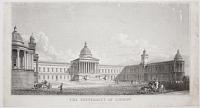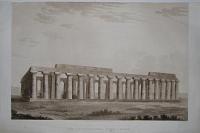Results 1-2 of 2
<<< Previous 1 Next >>>

The University of London. From the Designs of W. Wilkins, M.A., R.A.
Eng.d by Tho.s Higham [c.1840]
Engraving, sheet 240 x 450mm (9½ x 17¾"). Surface abrasions.
The main building of University College London, constructed between 1825 and 1832 to designs by the architect and antiquary William Wilkins (1778-1839). Like Wilkins' other projects of the period, his ideas were stimulated by reading the works of John Howard, Jeremy Bentham, and continental Enlightenment authors.
[Ref: 46930] £140.00
(£168.00 incl.VAT)

View of the Pseudodipteral Temple at Paestum.
Engraved by T. Medland.
London: Novr. 1. 1806, Published by Longman, Hurst, Rees, & Orme, Paternoster Row.
Aquatint and etching in sepia, image 325 x 490mm. 12¾ x 19¼". Trimmed to image at top. Tatty extremities.
The Temple of Hera, built around 550 BC by Greek colonists, is the oldest surviving temple in Paestum. Paestum is the classical Roman name of a major Graeco-Roman city in the Campania region of southern Italy. Plate 12 to Chapter 6 of William Wilkins's (1778 - 1839) 'The Antiquities of Magna Graecia', Cambridge, 1807. Magna Graecia (Latin for "Greater Greece") is the name of the area in Southern Italy and Sicily that was colonised by Greek settlers in the eighth century BCE. Wilkins was an architect and one of the leading figures in the English Greek Revival of the early 1800s. On his tour of the classical antiquities of the Mediterranean he was accompanied by the Italian landscape painter Agostino Aglio, who had been commissioned by Wilkins as draughtsman on the expedition. Aglio supplied the drawings for the monument illustrations in Wilkins' folio volume. In 1837 Wilkins became Professor of Architecture at the Royal Academy in succession to Sir John Soane. Abbey Travel: 128, 61.
[Ref: 9579] £180.00
(£216.00 incl.VAT)
<<< Previous 1 Next >>>

